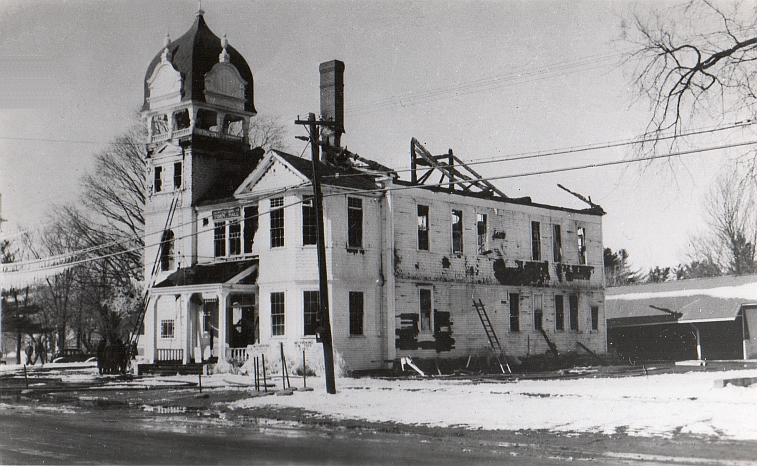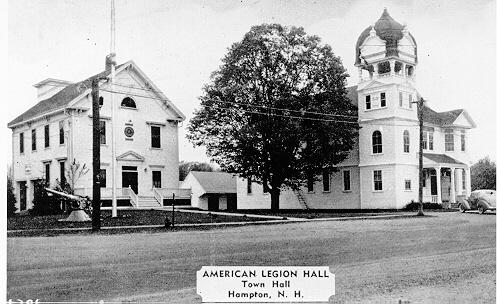(1797 — 1949)
By John M. Holman, Contributing Writer
This building, though not as old as many others in Hampton, was built in May 1797, when the Congregational Society ceased to worship in the log meeting house on what is now Meeting House Green near the Tuck Memorial Museum at 40 Park Avenue. This church, (later to become the Town Hall), the fifth meeting house, had box pews, a high pulpit, a sounding board and galleries. It was used as a church until around 1843-44, when the present Congregational Church was erected.
Rev. Roland D. Sawyer, of Kensington, NH, had the following to say in his weekly column of Hampton Union “Views and Reviews of Old Rockingham” in the Janury 15, 1948 edition: “After the old church was vacated, the town began to use it for town purposes, and continued to do so without any alterations up to 1860. The old meeting house, as it was then called, stood sidewise of, and mainly in the street, with a tall steeple at the west end, which contained ‘Grandsir’ Hardin’s favorite pet (the bell) and its apex crowned with a quaint weather vane that many still remember. (It is believed that this same weather vane is the one on display in the Tuck Museum).
“During this year, however, land was purchased, the steeple taken down, and the old building was swung around and moved back, end to the street. The gallery, which occupied three sides, and most of the box pews, were removed; the upper story floored over and other alterations and repairs made until it became quite a respectable building.
“Notwithstanding, as time wore on, it became apparent that a more commodious and modern structure was needed, and as the massive frame work of the old building was found to be in a good state of preservation, the town decided to thoroughly renovate the same and build an addition to the front, which was accordingly done.
“This affords a spacious hallway at the head of which is the selectmen’s room, light and airy. Farther to the left is the entrance to the upper hall, which has two anti-rooms, sufficient stage room, and back stairway, with seating capacity of 350 (in the hall).
“On the lower floor, at the right of the main entrance, is the library room, 15 by 30 feet; a hall, 45 by 50 feet, that is ample for town business, at the rear of which is a large kitchen, desk room and a lockup with two cells and other conveniences. Under the front stairway is a wood and coal room, the safe and ticket office. The building is well lighted and heated by two furnaces. Upon the whole, we pride ourselves with having as well an appointed town house as most of the country towns.”
Fifteen months after the forgoing article was written by Rev. Sawyer, on March 19, 1949, the HAMPTON TOWN HALL burned and was never rebuilt. The original Town Hall sign is on permanent display at the TUCK MEMORIAL MUSEUM. The present Town of Hampton offices are situated on the site of the old Town Hall.
(later the Hampton District Court Building)
and the old Town Hall (originally, the First Congregational Church).
An Historic Sign Survives The Fire
(1797 – Hampton Town Hall – 1949)
By John M. Holman, Contributing Writer
When the Town Hall ruins were removed from the fire site and transported to the Municipal Town Dump, the sign itself was among the debris. My father, Marshall S. Holman, was taking some trash to the dump on the same day and noticing the Town Hall sign inches away from flames (they used to burn the dump in those days), retrieved it before it was engulfed in flames and put it in his barn for safe keeping. Years later, when the sign was found in the barn, it was ultimately removed to the Tuck Museum for permanent display, where it can be seen today.
O. R. Cummings, author of “TROLLEYS TO THE CASINO – Exeter, Hampton & Amesbury Street Railway”, published January 1, 1969, made further mention of the Hampton Town Hall fire in his history of the E.H.& A. trolley system: “An interesting aftermath of the municipal operation of the Exeter, Hampton & Amesbury (Street Railway) occurred in March 1949 when the Hampton Town Hall was destroyed by fire. One item of property saved was an old wall clock, which formerly had hung in the office at the Hampton carhouse. When the barn was sold in 1927, the clock was installed in the Hampton town clerk’s office, where it became known as the $80,000 clock, symbolizing Hampton’s loss in its ill-fated street railway venture. Stored briefly after the fire, it later was returned to useful service in the town clerk’s quarters in a new municipal office building.”
[It now can be seen in the Selectmen’s Meeting Room, downstairs, in the “New” Town Office building at 100 Winnacunnet Road and still keeps good time.]

